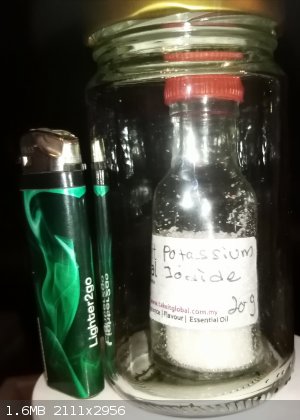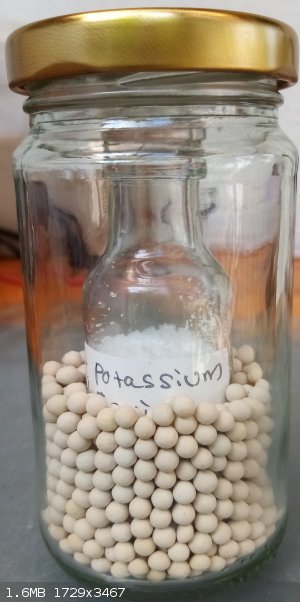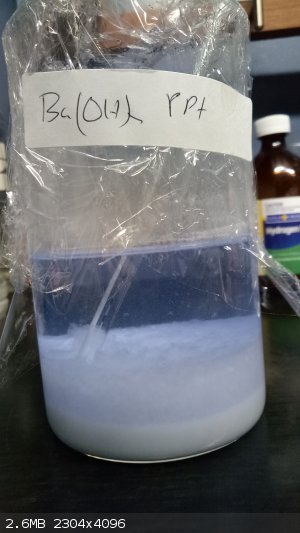| Pages:
1
..
93
94
95
96
97
..
104 |
macckone
Dispenser of practical lab wisdom
    
Posts: 2168
Registered: 1-3-2013
Location: Over a mile high
Member Is Offline
Mood: Electrical
|
|
Quote: Originally posted by BauArf56  | | Once i wanted to see how does propane (or butane) burn in chlorine gas, so i lighted up the blowtorch inside a bottle filled with chlorine. It burned
with a bigger flame and it was quite luminous too. After a few seconds of burning inside the bottle there was no smell of chlorine at all, just the
typical sweet smell of chlorinated compounds. Can anyone explain which compounds form and if is it possible to isolate them as liquids? Thanks
|
A wide variety of chlorinated compounds will form. Industrially, chlorinations are done in such a way as to avoid long chain hydrocarbons at high
temperatures and high chlorine concentrations. Generally the amount of chlorine is regulated to give a mono, di or tri substituted base. Separating
the compounds requires a lot of work unless it is something simple like methyl chloride, methylene chloride, chloroform and carbon tetrachloride.
|
|
|
Sulaiman
International Hazard
    
Posts: 3692
Registered: 8-2-2015
Location: 3rd rock from the sun
Member Is Offline
|
|
KOH or CaCl2 to dry KI?
I want to dry 20g of KI to weigh it for redox titrations, I intend to use a jam jar as a dessicator

(disposable lighter for scale reference only)
which would be 'best', CaCl2 or KOH?
I guess that the long narrow neck of the bottle will slow down the dehydration,
but I'm not in a hurry.
CAUTION : Hobby Chemist, not Professional or even Amateur
|
|
|
Sulaiman
International Hazard
    
Posts: 3692
Registered: 8-2-2015
Location: 3rd rock from the sun
Member Is Offline
|
|
Answered my own question...I have 3A molecular sieves.

CAUTION : Hobby Chemist, not Professional or even Amateur
|
|
|
Fulmen
International Hazard
    
Posts: 1716
Registered: 24-9-2005
Member Is Offline
Mood: Bored
|
|
Is there any interesting to do with ammonium dihydrogen phosphate from fire extinguishers? I have at least 5kg of the stuff, but it's pretty messy to
work with. I don't know if it's treated with anything hydrophobic but it doesn't really mix with water.
We're not banging rocks together here. We know how to put a man back together.
|
|
|
BauArf56
Hazard to Self
 
Posts: 68
Registered: 22-8-2019
Location: between the moon and the sun
Member Is Offline
Mood: energetic
|
|
3 stupid questions:
1. How to make calcium nitrate from potassium nitrate? I tried mixing KNO3 and CaCl2 but i don't really know if it worked and if i can separate it
from potassium chloride.
2. How to make ammonium nitrate from KNO3?
3. i distilled a mix of sodium bisulfate and potassium nitrate (40g of NaHSO4 and 20g of KNO3, as NurdRage says) and got a few drops of yellow nitric
acid, plus lots of nitrogen dioxide. Strange thing is that it fumed when i blown over it, so could it be the super concentrated stuff? And why a such
low yield?
|
|
|
Keras
National Hazard
   
Posts: 896
Registered: 20-8-2018
Location: (48, 2)
Member Is Offline
|
|
I would turn KNO₃ into pure nitric acid (you can do that with NaHSO₄, as demonstrated by Nurd Rage's video), and then you neutralise your acid
with either calcium carbonate (lime stone) or ammonia, case 1. and 2. I'm pretty sure you can't get Ca(NO₃)₂ from KOH – though that might work
to some extent [this is linked to the relative alkalinity of KOH and Ca(OH)₂]. However, NH₃ being a weak base, there's no way to turn KNO₃ into
NH₄NO₃.
3. Pay attention to stoichiometry. Nurdrage uses 43 g of KNO₃ and 150 g of NaHSO₄. If you use 20 g of potassium nitrate, you would have to use 80
g of sodium bisulphate to place yourself in the same conditions and get the same yield.
|
|
|
karolus28
Hazard to Self
 
Posts: 51
Registered: 14-4-2019
Location: EU's Brazil
Member Is Offline
Mood: zgrzyt
|
|
A question related to the legendary lead chamber processe:
Let me start by saying that I did the lead chamber process but it was kinda shit, 20-25 burning cycles, about 300 ml of water at the bottom, small
burning pot on a 250 beaker, the bottom of the beaker would get some nitrosylsulfuric acid after a few burns. I didn't actually do much stoichiometry
because I didn't have a good scale and that might explain why it was dilute as shit even after boiling to 20 ml, although it worked since I previouslu
used a copper stand and the solution got a bit of blue. Now bact to the problem -the sulfur and KNO3 wouldn't react- both were bought as reagents,
mixed together, no matter how much heat would I put into it, the sulfur just burned for a while and then went off leaving clumped/molten KNO3 on the
top. I realized that I can use a tiny tiny amount of sugar to make the magic happen, so the plan was to put some KNO3 in the pot(45 degree angle), and
then on top put a mixture of sulfur, little bit of sugar, little bit of KNO3 and on top of that put pure sulfur that gives me time to close the bucket
before the violent reaction starts that lasts like 10-15 seconds.
The actual question is, how do I make the mix burn like it is in theory mean to burn?
In this video the NO2 fumes are clearly visible: https://youtu.be/7XVt_ca97WE?t=305
This is how I usually ignited all that https://www.youtube.com/watch?v=KwYA7ojSodc
Good God why do I talk so much?
|
|
|
TheMrbunGee
Hazard to Others
  
Posts: 364
Registered: 13-7-2016
Location: EU
Member Is Offline
Mood: Phosphorising
|
|
Quote: Originally posted by karolus28  | A question related to the legendary lead chamber processe:
Let me start by saying that I did the lead chamber process but it was kinda shit, 20-25 burning cycles, about 300 ml of water at the bottom, small
burning pot on a 250 beaker, the bottom of the beaker would get some nitrosylsulfuric acid after a few burns. I didn't actually do much stoichiometry
because I didn't have a good scale and that might explain why it was dilute as shit even after boiling to 20 ml, although it worked since I previouslu
used a copper stand and the solution got a bit of blue. Now bact to the problem -the sulfur and KNO3 wouldn't react- both were bought as reagents,
mixed together, no matter how much heat would I put into it, the sulfur just burned for a while and then went off leaving clumped/molten KNO3 on the
top. I realized that I can use a tiny tiny amount of sugar to make the magic happen, so the plan was to put some KNO3 in the pot(45 degree angle), and
then on top put a mixture of sulfur, little bit of sugar, little bit of KNO3 and on top of that put pure sulfur that gives me time to close the bucket
before the violent reaction starts that lasts like 10-15 seconds.
The actual question is, how do I make the mix burn like it is in theory mean to burn?
In this video the NO2 fumes are clearly visible: https://youtu.be/7XVt_ca97WE?t=305
This is how I usually ignited all that https://www.youtube.com/watch?v=KwYA7ojSodc
Good God why do I talk so much? |
I am unfamiliar with this process, but I have played with KNO3/S pyrotechnic mix, and know they do react. As I understand there is not a lot of KNO3
in that mixture, that is why reaction is not energetic at all.
I would recommend grinding KNO3 (and sulfur) as fine as You can or even use water to mix it with S, making a paste and actively drying it making
homogenous mix of molecules, that might help it burning completely. I guess sulfur boiling point is lower than decomposition of KNO3, so it never
does. (too lazy to check)
|
|
|
karolus28
Hazard to Self
 
Posts: 51
Registered: 14-4-2019
Location: EU's Brazil
Member Is Offline
Mood: zgrzyt
|
|
Well, I tried mixing the sublimed sulfur with somewhat powdery KNO3 1:1, blasted it with a mini blowtorch and nothing really happened. If you put a
pinch of sugar it burns like rcandy with very bright light. I might try doing this again
Hi, please read about exif data.
|
|
|
TheMrbunGee
Hazard to Others
  
Posts: 364
Registered: 13-7-2016
Location: EU
Member Is Offline
Mood: Phosphorising
|
|
Quote: Originally posted by karolus28  | | Well, I tried mixing the sublimed sulfur with somewhat powdery KNO3 1:1, blasted it with a mini blowtorch and nothing really happened. If you put a
pinch of sugar it burns like rcandy with very bright light. I might try doing this again |
I think You need about 1 part of S for 4 parts of KNO3, try that mixture. Otherwise molten sulfur just extinguishes reaction like water would.
Edit: The sulfur melts first, so fineness of it does not matter as much as fineness of KNO3. Only bet to get this working with Your proportions is to
get KNO3 as fine as possible, If its doable at all.
[Edited on 31-8-2021 by TheMrbunGee]
|
|
|
karolus28
Hazard to Self
 
Posts: 51
Registered: 14-4-2019
Location: EU's Brazil
Member Is Offline
Mood: zgrzyt
|
|
Tried 1:4 today, worked. The only difference was that I had the mixture on Al foil with a lighter underneath. It's just that lighting it from the top
doesn't work.
thanks
Hi, please read about exif data.
|
|
|
karlos³
International Hazard
    
Posts: 1520
Registered: 10-1-2011
Location: yes!
Member Is Offline
Mood: oxazolidinic 8)
|
|
Ok so I want to follow this theobromine extraction procedure: https://biochemicalponderings.wordpress.com/2017/03/18/theob...
Even made magnesium hydroxide just for this process, but that crappy substance is so hard to filter out 
My short question would be, can I replace the magnesium hydroxide simply with sodium hydroxide, it is used to form insoluble tannate salts, would NaOH
be a suitable substitute for this?
verrückt und wissenschaftlich
|
|
|
DraconicAcid
International Hazard
    
Posts: 4332
Registered: 1-2-2013
Location: The tiniest college campus ever....
Member Is Offline
Mood: Semi-victorious.
|
|
Sodium hydroxide should be okay, but calcium carbonate should also work (that's the base of choice in the caffeine extraction I have notes for), and
is less harsh.
Please remember: "Filtrate" is not a verb.
Write up your lab reports the way your instructor wants them, not the way your ex-instructor wants them.
|
|
|
karlos³
International Hazard
    
Posts: 1520
Registered: 10-1-2011
Location: yes!
Member Is Offline
Mood: oxazolidinic 8)
|
|
Thank you! 
I just can't get the Mg(OH)2 I made out of the aqueous suspension it is in, so I guess I'll stick with NaOH.
If it turns out this was not an as well working alternative, then I guess I can still fix any issues resulting from that later, shouldn't be that bad.
verrückt und wissenschaftlich
|
|
|
UC235
National Hazard
   
Posts: 565
Registered: 28-12-2014
Member Is Offline
Mood: No Mood
|
|
How about buying some food grade lime? Calcium hydroxide. That will be a lot closer than NaOH.
|
|
|
DraconicAcid
International Hazard
    
Posts: 4332
Registered: 1-2-2013
Location: The tiniest college campus ever....
Member Is Offline
Mood: Semi-victorious.
|
|
You can't get magnesium hydroxide as an antacid where you live? Unflavoured antacid tablets should work just fine for this prep.
Please remember: "Filtrate" is not a verb.
Write up your lab reports the way your instructor wants them, not the way your ex-instructor wants them.
|
|
|
karlos³
International Hazard
    
Posts: 1520
Registered: 10-1-2011
Location: yes!
Member Is Offline
Mood: oxazolidinic 8)
|
|
Well I have around 800ml of selfmade "milk of magnesia" now, it just clogs up everything.
I actually took the required amount of MgSO4 7H20, dissolved this in water and added the respective amount of NaOH to precipitate the Mg(OH)2, its
just that this annoying fine precipitate is a bit like cement when fresh prepared, or such...
Guess I could try it through a piece of cloth instead, that might work better.
I mean, its the exact quantity and substance I need, even if I can't filter it through the frit, I should still try to filter it out somehow.
verrückt und wissenschaftlich
|
|
|
j_sum1
Administrator
       
Posts: 6320
Registered: 4-10-2014
Location: At home
Member Is Offline
Mood: Most of the ducks are in a row
|
|
Interesting shade of blue encountered while recycling some barium. I wonder if anyone can help me identify it.

I did the classic Ba(OH)2 + NH4Cl endothermic reaction and decided to convert the product back to hydroxide.
I first made sure that Ba(OH)2 was in excess. And it was left for a few days so that most of the ammonia had a chance to escape.
I then added water and HCl to dissolve the solid. I thought to convert everything to BaCl2, but there did remain some cloudiness.
I then added a concentrated solution of NaOH to precipitate the Ba as hydroxide. That is when the blue appeared. I thought it was Raleigh scattering
at first, but it persisted even when the mixture became fully opaque and also afterwards when the sediment began to settle. There was an ammonia smell
indicating that ammonium salts were still present.
It seems that I have two crops of crystals: a fine powder that settled immediately and some larger fluffy ones that crystallised later.
But I am not sure about the blue or what might be causing it.
Thoughts?
|
|
|
S.C. Wack
bibliomaster
    
Posts: 2419
Registered: 7-5-2004
Location: Cornworld, Central USA
Member Is Offline
Mood: Enhanced
|
|
Perhaps it's something complexed to the ammonia. I'd do things with the filtrate and see what happens.
BTW it takes little excess acid to precipitate the chloride, so the purity of your precipitate is unclear.
|
|
|
j_sum1
Administrator
       
Posts: 6320
Registered: 4-10-2014
Location: At home
Member Is Offline
Mood: Most of the ducks are in a row
|
|
That's much the same conclusion I came to. But I eould not expect Ba to form such a complex. Which leaves impurities. And who knows quite what thry
might be.
|
|
|
DraconicAcid
International Hazard
    
Posts: 4332
Registered: 1-2-2013
Location: The tiniest college campus ever....
Member Is Offline
Mood: Semi-victorious.
|
|
Agreed. Ammonia isn't going to complex to barium, and it's tough to imagine a barium compound that's going to be blue because of the barium.
Please remember: "Filtrate" is not a verb.
Write up your lab reports the way your instructor wants them, not the way your ex-instructor wants them.
|
|
|
S.C. Wack
bibliomaster
    
Posts: 2419
Registered: 7-5-2004
Location: Cornworld, Central USA
Member Is Offline
Mood: Enhanced
|
|
The involvement of Ba or not is of course easily decided by removing it. Same for ammonia. After that, changing the oxidation state may help.
|
|
|
j_sum1
Administrator
       
Posts: 6320
Registered: 4-10-2014
Location: At home
Member Is Offline
Mood: Most of the ducks are in a row
|
|
Contamination may have come via the acid. I buy hardware store HCl and I have had issues in the past with titanium contamination of all things. I
normally distil out azeotropic HCl for everyday use. However, it is possible that some diluted undistilled acid made its way into the mix.
I have played with Ti complexes before. I do not recall a blue ammonia complex. So that is puzzling to me.
I will test the supernatant liquid and see if I can drtect either ammonia or titanium.
Another possible contaminant is iron. Where I live is a large amount of red dust that is predominantly Fe2O3 snd it gets everywhere. But, again, a
blue complex has me stumped.
The NH4Cl is analytical grade. The Ba(OH)2 is old stock of unknown assay rescued from a throw out pile. I fully expect it contains carbonate after
probably 30 years of storage, but that should change little.
I have a second batch that I will process the same way but a little more carefully and see if I get the same result. I may as well get some benegit
from a failed video.
|
|
|
Morgan
International Hazard
    
Posts: 1694
Registered: 28-12-2010
Member Is Offline
Mood: No Mood
|
|
Black quartz
What might the black color be from?
https://www.heraeus.com/en/hca/products_hca/hbq_black_quartz...
|
|
|
walruslover69
Hazard to Others
  
Posts: 232
Registered: 21-12-2017
Member Is Offline
Mood: No Mood
|
|
probably either magnetite which is what makes obsidian black, or carbon powder. can't be certain though
|
|
|
| Pages:
1
..
93
94
95
96
97
..
104 |